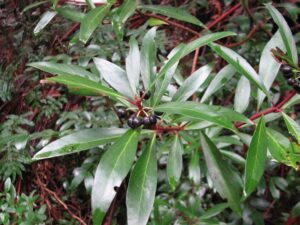
Edimental Tasmannia?
By Clive Larkman
Plants in the garden fill so many parts of our lives. The ‘Edimentals’ are the best, as they are both attractive, useful in the kitchen and some have medicinal value as well. You can tick another box if they are Australian natives. One group that fits all these is the genus Tasmannia.
Tasmannia consists of thirty-six species spread across Australia and New Guinea as well as a single species that is found in SE Asia. They belong to an unusual family called Winteraceae, which is an old family dating back 35 to 100 million years and covered most parts of Gondwanaland. Winteraceae is classed as a primitive family and is mostly found in the regions from Madagascar, east through Australasia, to South America, and northerly into some subtropical regions of Central America, SE Asia, and the Pacific Islands. It is an unusual spread that only makes sense when taken in line with the movement of Gondwana from the great Southern Land, to make up Australia, South America, and the lands in between.

The family has five genera with around ninety species. There are morphological characteristics that help define a family and these can form a linear progression that gives a chronological evolutionary link between families. Some are very primitive and indicate that members of that family go back many millennia. Others are more recent and only go back a few thousand years. This is a simplification that has caused some misunderstanding of many genera. Plants in the Winteraceae lack xylem vessels which significantly reduces the movement of water through the plant. It was initially thought that this was due to the age of the family but in later research (and thinking) it was determined that this was a reverse evolutionary trait. As the parts of Gondwana moved, the climates changed and many species ended up in areas that went from hot and humid to cold and freezing conditions. An adaptation to this is the excising of the xylem vessels which stops the fatal damage caused when they freeze.
The genus Tasmannia is the largest in the family from Australasia, and just to confuse things, it is spelled with a double ‘n’. This also highlights the fact the genus name does not mean that the plants are endemic to Tasmania. Indeed, some species do not even occur in the island state. However, just like the state, the genus was named after the Dutch explorer Abel Tasman, the first European to map Australia, New Zealand, and the surrounding islands. In the modern world he may not be as respected as he should be. Many of these early explorers brought European colonisation which is seen by some as a negative. However, Abel Tasman was a great navigator and travelled the world in the mid-1640s. He mapped much of the southern oceans and generated new trade between Europe and SE Asia.
The genus, first described in the mid-1770s was seen as an interesting plant for generating flavours in cooking and for its medicinal properties. The plants are small to large shrubs and even occasionally small trees. Most species are dioecious, producing spicy berries from attractive clusters of white to yellow flowers. The majority have red stems and lanceolate simple leaves with oil sacs on the leaves.
Many species are now being used for oil and culinary purposes. The foliage, flowers and fruits are all edible and are used widely around the world. Many indigenous peoples use the foliage and fruit for flavouring and in their homeopathic medicines. The plants are attractive as shrubs due to the clean colours of the foliage and the stems, and with their pretty floral display which is usually in summer. The plants are mostly tolerant of moderate frosts, high humidity and extended dry periods. They are perfect ‘Edimentals’ for the Aussie home garden!
